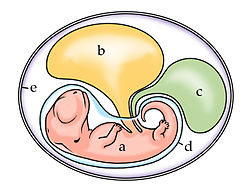Extraembryonic membrane: Difference between revisions
From AnthroWiki
(Created page with "The embryo with its four extraembryonic membranes (embryonic membranes): a = embryo, b = yolk sac, c = allantois (embryonic urinary bladder), d = amnion (bloodless inner egg m...") |
No edit summary |
||
| Line 1: | Line 1: | ||
The embryo with its four extraembryonic membranes | [[File:Amniote embryo.jpg|mini|250px|The embryo with its four extraembryonic membranes: a = embryo,<br />b = yolk sac,<br />c = allantois (embryonic urinary bladder),<br />d = amnion (bloodless inner membrane),<br />e = chorion (strongly perfused outer villous membrane).]] | ||
The '''extraembryonic membranes''' or '''eggshell membranes''', also called '''amniotic membranes''' or '''germinal membranes''', surround the maturing [[embryo]]. The four [[w:membrane|membrane]]s, which are formed from the embryonic tissue and correspond to the 4 basic [[members]] of the being, are: | The '''extraembryonic membranes''' or '''eggshell membranes''', also called '''amniotic membranes''' or '''germinal membranes''', surround the maturing [[embryo]]. The four [[w:membrane|membrane]]s, which are formed from the embryonic tissue and correspond to the 4 basic [[members]] of the being, are: | ||
Revision as of 09:58, 30 March 2021
The extraembryonic membranes or eggshell membranes, also called amniotic membranes or germinal membranes, surround the maturing embryo. The four membranes, which are formed from the embryonic tissue and correspond to the 4 basic members of the being, are:
- the yolk sac (Latin: Saccus vitellinus) with the nutrient-rich yolk (Greek: λέκιθος lekithos, Latin: vitellum, from vita "life") serves exclusively as a nutritional organ and corresponds to the physical body,
- the amnion (Greek: ἀμνίον amníon "that which belongs to the little lamb"), also called sheepskin, as a thin, vesselless inner egg shell filled with amniotic fluid, which forms the amniotic sac in the narrower sense[1], is related to the etheric body,
- the allantois (Greek: αλλαντοίς "the sausage-shaped"), which serves as the embryonic urinary bladder and correlates with the astral body,
- the chorion (Greek: Χορίον "villous skin"), which is the physical correlate of the I-organisation as the strongly perfused outer membrane. The secondary villi of the chorion grow into the maternal endometrium (from Greek: ἔνδο éndo "inside" and μήτρα mḗtrā "uterus") and together with this form the [[w:placenta (Latin: placenta "cake"), to which the embryo is connected via the umbilical cord.
At birth, the extraembryonic membranes, the placenta and the umbilical cord are rejected as afterbirth and die.
Literature
- Kaspar Appenzeller: Die Genesis im Lichte der menschlichen Embryonalentwicklung, 2. Auflage, Zbinden Verlag 1989, ISBN 978-3859893825
- Wolfgang Schad (Hrsg.): Die verlorene Hälfte des Menschen: Die Plazenta vor und nach der Geburt in Medizin, Ethnologie und Anthroposophie, 3. Auflage, Verlag Freies Geistesleben, Stuttgart 2016, ISBN 978-3772514654
- Rudolf Steiner, Ita Wegman: Grundlegendes für eine Erweiterung der Heilkunst nach geisteswissenschaftlichen Erkenntnissen, GA 27 (1991), ISBN 3-7274-0270-9 Template:Schriften
- Rudolf Steiner: Fachwissenschaften und Anthroposophie, GA 73a (2005), ISBN 3-7274-0735-2 English: rsarchive.org German: pdf pdf(2) html mobi epub archive.org
- Rudolf Steiner: Erdenwissen und Himmelserkenntnis, GA 221 (1998), ISBN 3-7274-2210-6 English: rsarchive.org German: pdf pdf(2) html mobi epub archive.org
- Rudolf Steiner: Physiologisch-Therapeutisches auf Grundlage der Geisteswissenschaft. Zur Therapie und Hygiene, GA 314 (1989), ISBN 3-7274-3141-5 English: rsarchive.org German: pdf pdf(2) html mobi epub archive.org
- Rudolf Steiner: Meditative Betrachtungen und Anleitungen zur Vertiefung der Heikunst, GA 316 (2003), ISBN 3-7274-3160-1 English: rsarchive.org German: pdf pdf(2) html mobi epub archive.org
 |
References to the work of Rudolf Steiner follow Rudolf Steiner's Collected Works (CW or GA), Rudolf Steiner Verlag, Dornach/Switzerland, unless otherwise stated.
Email: verlag@steinerverlag.com URL: www.steinerverlag.com. Index to the Complete Works of Rudolf Steiner - Aelzina Books A complete list by Volume Number and a full list of known English translations you may also find at Rudolf Steiner's Collected Works Rudolf Steiner Archive - The largest online collection of Rudolf Steiner's books, lectures and articles in English. Rudolf Steiner Audio - Recorded and Read by Dale Brunsvold steinerbooks.org - Anthroposophic Press Inc. (USA) Rudolf Steiner Handbook - Christian Karl's proven standard work for orientation in Rudolf Steiner's Collected Works for free download as PDF. |
References
- ↑ Depending on the definition, the totality of the egg shells, or namely the amnion and chorion together, is also called the amniotic sac.

